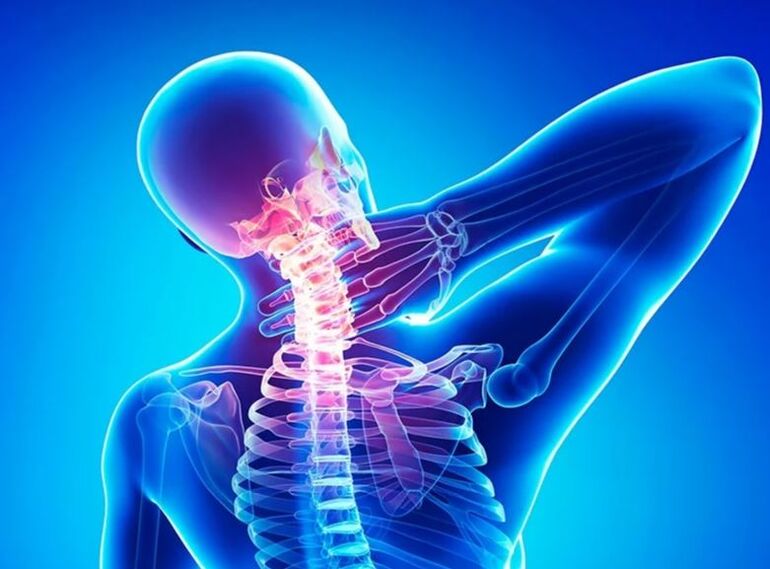
Disease description
Osteochondrosis is the pathological condition of bone-cheating spine.The disease is characterized by dystrophical changes and reduction of impact function from intervertebral disks.Pathology causes the deterioration of the ability to fasten the spinal column due to the reduction in the height of the intervertebral discs, as well as reducing the tons of spinal muscles and ligaments.
Several forms of osteochondroise differ depending on the localization of dystrophic changes: cervix, chest, lumbar, sacral.One of the most common is cervical osteochondrose (up to 25% of the total number).The disease follows unpleasant sensations that significantly reduce the quality of human life.
It is important that cervical osteochondrose can occur at any age.Currently, the disease is often diagnosed even in schools and students, which are connected with a seated lifestyle and long-term stay in computers and textbooks (subject to the wrong body position).
In the absence of treatment, osteochondrose progresses, symptoms become more pronounced, often complications occur: intervertebral hernia, nerve rings, circulatory, hypoxia, etc.
Symptoms
With cervical osteochondrose, not sufficient nutrition of intervertebral discs of cervical disks, from which they become fragile, and the distance between them is largely decreasing.At the same time, bone tissue becomes prone to growing and forming the growth of bones (osteophytes).In later phases, growth is moving and start compressing in nearby tissues, vessels and nerves that take place in the cervical region.
Cervical osteochondrosis- Chronically, gradually developing a disease.Therefore, the symptoms of pathology in different phases are different.
- Symptoms of osteochondrose 1. Degree
In the initial phase of the disease, there is a slight decline in the height of the height of the inverter's spine of the cervix.Pathology has mild symptoms.There is discomfort in the neck, which can be extended to shoulders.In some cases, neck pain may occur, manifested in physical activity. - Symptoms of osteochondrose 2. degrees
At this stage, the disk height continues to be reduced, there is no wrong growing cartilage, the protrusion is developed.Cracks can be formed in a fibrous ring.The pain begins to intensify, it becomes longer, can radiate in the hands and the spine.There is a feeling of stiffness with the turns of the door, crumb and the appearance of headaches are possible. - Symptoms of osteochondrose 3. Degree
In the third phase of the disease, fibrous ring stops and the formation of intervertebral hernia.The spine charum is deformed, dislocations or subluxation of vertebrae can occur.The patient feels acutely, extended neck pain, numbness, partial loss of skin areas in the skin, neck, shoulders or hands. - Fourth degree osteochondrosis symptoms
In an advanced stage of the disease, irreversible changes appear - numerous osteophytes develop, the intervertebral disk structure gradually replace the fabric scarf.The resulting hernia press on blood vessels and nerves, a person has the hypoxia of bodies, pathology of the circulation system.The pain lasts a long, neck and upper shoulder belt becomes immobilized, the quality of life has been significantly worse.
Regardless of the seriousness of the disease, the patient may have such symptoms as headache, noise, or ringing in ears, nausea, various vision impairment (flickering, darkening, pain).
Reasons
Cervical osteochondrosis occurs due to irregularly distributed load on the thunderstorms.At the same time, the neck muscles cannot be handled with mechanical pressure, spasm, which leads to circulatory disorders.From this, degenerative changes come in upper spine.
Factors that contribute to the development of osteochondrose of the cervical spine:
- hereditary predisposition;
- Door injury;
- Sedentary lifestyle;
- Long stay in one position - on a computer, driving, etc.;
- The presence of autoimmune diseases is rheumatoid arthritis, systemic lupus erythematosus,
- scleroderma;
- Breach of metabolism;
- The presence of endocrine diseases - gout, diabetes;
- Excessive body weight.
Diagnostics
If there is any doubt about the presence of cervical osteochondrose, it is necessary to contact the medical institution in a timely manner.A comprehensive diagnosis will help identify diseases, assess her degree and understand the causes of pathology development.The preliminary diagnosis is performed on the basis of inspection and palpation - with osteochondrose, the tension of cervical muscles is noticed, in some cases the spine deformity was observed.
After objective diagnosis, the doctor sends the patient to additional studies.
The following diagnostic methods are used to confirm the diagnosis:
- Magnetic resonance imaging;
- Radiography (side and flat);
- Multilayer computer tomography.
To determine the reason for the development of pathology, ultrasonic overview of the nearby bodies, the ECG hearts, the duplex scan of blood vessels, blood vessels and urine can be further prescribed.
Therapeutic treatment
With timely detection of cervical osteochondrose, the disease is well borrowed by therapy treatment.Unfortunately, osteochondrosis cannot be completely cured, however, therapy will help prevent further disease development, mitigate unpleasant symptoms and normalization of the mobility of the upper spine.
The following methods are used for this:
- Treatment of medicines.Drugs relieve pain and inflammation, return blood circulation and remove cramps in neck muscles.The following groups of drugs can be used for this: Glucocorticosteroids, analgesics, slowing medications, muscle relaxants, etc.
- Physiotherapy treatment.In addition to taking drug relaxation, eliminate the cramps and normalization of blood circulation will help physiotherapy procedures: massage, acupuncture, laser effect, magnetotherapy, UHF therapy, phonoporesis, etc.
- Therapeutic gymnastics.Special physical exercises will help the patient strengthen the muscle framework, align the posture and improve blood supply to the upper part of the spinal column.
Surgical treatment
In the case of advanced stages of osteochondrose of the cervical spine or with insufficient efficiency of conservative methods, operation is required.
The following operations can be used depending on the specific clinical case:
- Small invasive removations of the spine.
- The laminektomy is a ribbon removal operation.
- Removing the kile and stabilization of the operated segment using a system consisting of four titanium screws and two top of the bars.
- Endoscopic removal of hernia.



















